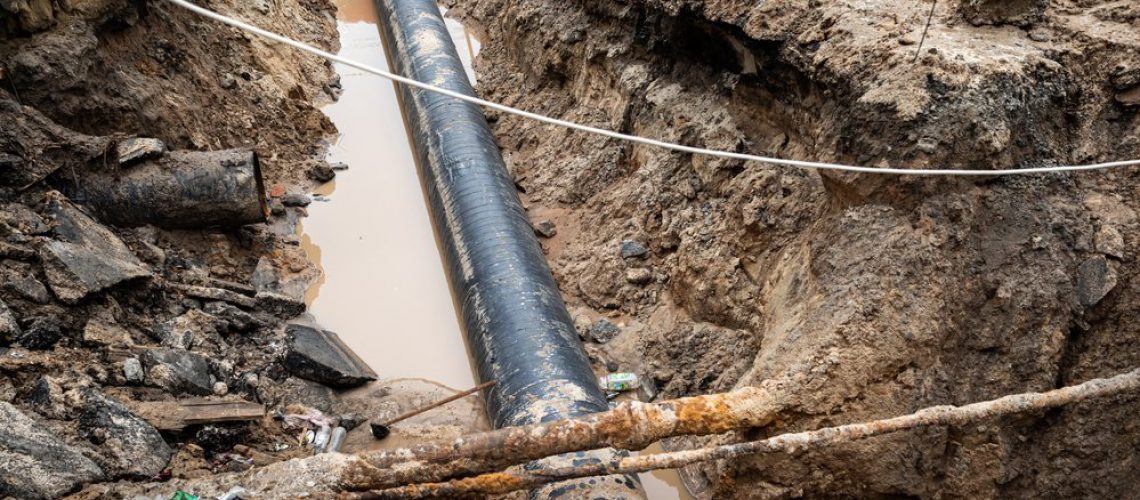Never begin a digging project without first knowing what is buried underground. Hitting an unknown utility that was buried can be incredibly dangerous and very expensive. Luckily, finding underground pipes can be accomplished with good planning, good preparation and a little bit of knowledge.

The equipment you’ll need to find underground pipes and lines will depend entirely on the material used for the utility line. Materials typically seen in underground lines include: metal, PVC (polyvinyl chloride), and plastic. Keep in mind that if you are trying to find lines under any type of building material, the equipment will need to be able to penetrate that as well.

Locating Underground Water Lines Made of PVC
A metal detector is useless when it comes to finding underground pipes made of PVC since there is no metal in the material. The tool you would need to find the PVC pipes is called a ground penetrating radar (GPR). The GPR will accurately detect PVC as well as metal pipes.
If you are lucky and your PVC pipes were installed with a tracing wire, you will be able to find them using a hand-held pipe finding tool. These tools range in price and quality from $300 to $3,500. When purchasing a new hand-held pipe finding tool, be sure to educate yourself on how to use it properly because there is a learning curve with these tools.
If your PVC was not installed with a tracing wire, a fiberglass probing wire can be put through the pipe. This can only be done in systems that can be completely shut down and disconnected. Once shut down, the tracing wire can be fed through the system. Scanning using the pipe locator tool can then be done to find where the pipes lay.
When dealing with unmarked PVC pipes, there are two options available to you. First, you can use a manual probe or reach out to a professional to help map out these unmarked pipes. Manual probing consists of manually pushing a metal probing rod into the ground to look for the pipes. The rods themselves are reasonably inexpensive, however, the process is immensely time consuming and frustrating.
A method used by professionals to find PVC pipes is acoustic pipe locating. Unfortunately, this method only works when the pipe has already been damaged and the pipe is leaking. Obviously, we want to find the buried pipes before this happens. To ensure you are finding all unmarked PVC pipes, consider getting the help of a professional with experience in underground utility mapping that specializes in 3D mapping.
Finding Underground Sinkholes Before They Collapse
Sinkholes can be extremely dangerous to any digging project. Sinkholes form when underground rock wears away over time from groundwater. While the rock is slowly wearing away, the surface of the soil can look perfectly normal. A digging project can trigger a sinkhole causing a lot of damage to equipment and human life. A collapsed sinkhole can range in size from a couple of feet to hundreds of feet. It is easier and more cost effective to reinforce a sinkhole prior to digging, before it collapses.
The area where you plan to dig should be surveyed completely with ground penetrating radar. This will ensure that you do not have any possible sinkholes in the area. This survey is especially important if you live in an area of the country that is prone to sinkholes or if you are seeing any visual signs of a possible sinkhole.

How to Locate a Water Line Underground
When it comes to locating underground water lines, it is prudent to contact a private utility locator. The process requires specialized equipment. Professionals will use one of two types of underground water pipe locator devices. Both ground penetrating radar and electromagnetic conductivity (EM) devices are used to determine where the lines are running on the property. With their specialized equipment they will be able to trace water pipes underneath ground surfaces. Locating water lines underground should be left to professionals so no damage is done while digging.
Locating Underground Drainage Pipes
Most drainage pipes are made of PVC, however, other materials can be used depending on the age of the lines. If you have PVC drainage pipes, refer to the previous section on locating PVC pipes. Typically, older homes built prior to the 60’s will have drainage pipes made of some type of metal (steel, iron, or copper). Metal pipes can be found using ferromagnetic detection (FM) or GPR.
Understanding The Difference Between Public And Private Utilities
Of paramount importance in the beginning phases of your dig project planning is understanding the difference between public utilities and private utilities. 811 is the national “call-before-you-dig” number. Anyone who plans to dig must call 811 or visit their state’s 811 website at least 2 business days before they plan to dig to request the underground utilities be marked. This is a free service, but they will only locate the public utilities that are part of the local infrastructure, such as water, sewer, electrical, and natural gas lines. And even then, these lines are normally only marked from the main line to the meter on your property. A private utility locator will be able to map out and locate any other lines in the ground on the property you are planning to dig.
Unless you are the original owner of the property you plan to dig, you may be unaware of what pipes are buried on the property. As time passes and lines become obsolete they are replaced with new ones while the obsolete lines are left buried. It is hard to find something you know nothing about.
Common Underground Private Lines That Could Be Hidden
- Exterior or landscape lighting
- Well water systems
- Heated pool lines (propane, natural gas)
- Septic systems
- Sprinkler and water features
- Storm drains
Finding and marking all the underground lines on your property before the project starts will prevent costly surprises and keep everyone on the job site and in the community safe.

